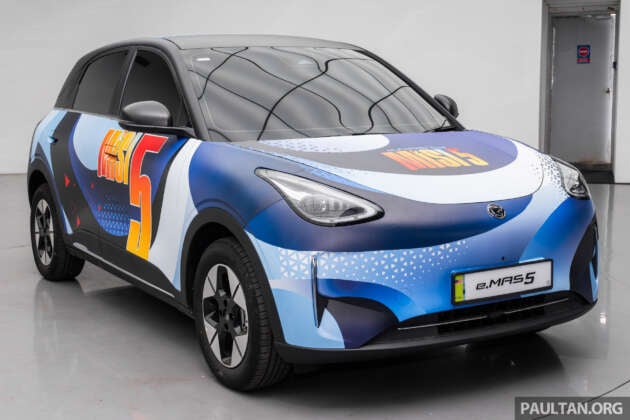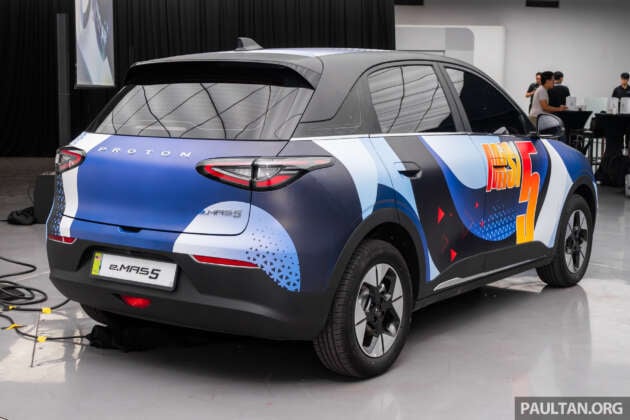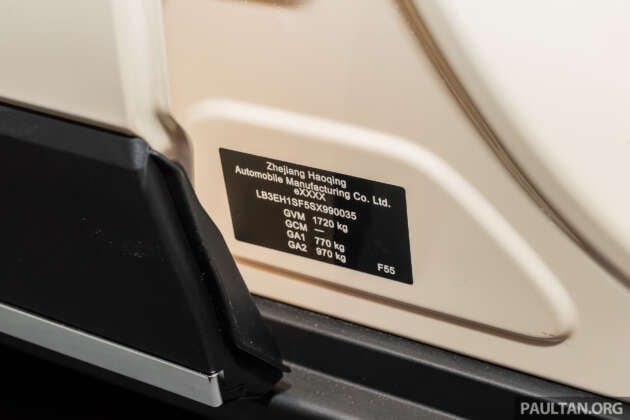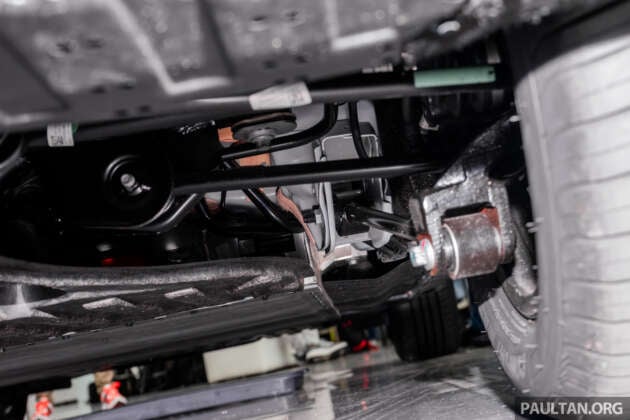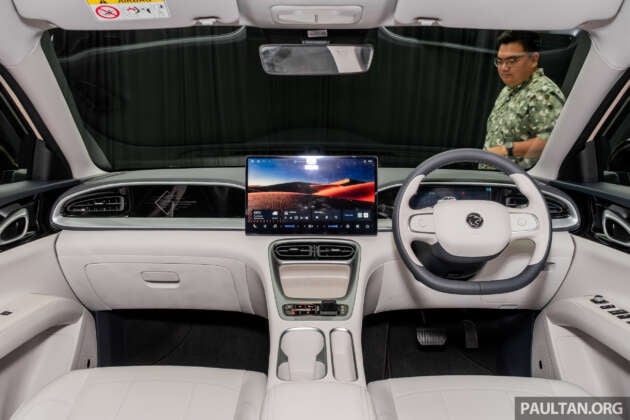Proton may have taken its time in getting the eMas 7 to market, but the national automaker is showing less inclination to linger about with its second all-electric offering, the eMas 5, which was first previewed to the public in camouflaged form at the Malaysia Autoshow in May.
Back then, it was stated that the compact, B-segment all-electric hatchback was due for a Q4 introduction this year, and it looks like things are pretty much on track. At this juncture, it could be out sometime in October, which is when the clad car seen in the photos here completes its ongoing MISI 5 Tour roadshow, or shortly after.
That things are gearing up towards that has been amplified by a full preview of the car, where a fully uncamouflaged pre-production unit was shown to the motoring press at the design centre in the COE earlier this week.
While exterior photos of the uncovered car in full weren’t allowed, limited to cropped shots (it’s the cream/off-white example seen in the partial external shots here), the interior was allowed to be revealed completely, as was the specifications of the lead variant, so without further ado, let’s dive into it.
Wish upon a star
It’s already known that the eMas 5 is not just based on the Geely Star Wish, it’s basically the same car. Introduced in China in October 2024, where it is known as the Geome Xingyuan, the five-door EV is a cheaper, smaller competitor to the BYD Dolphin. As noted previously, it’s also much more organic in shape, with rounded lines and gentle curves, and the overall design contains many smart-like cues in its flow and shape.
It seems Proton appears to be a lot more open about this being a rebadged model, having referenced the Geome’s sales success in China (it was the Middle Kingdom’s best selling EV in H1 2025) as a USP, as opposed to the co-developed claims bandied about during the eMas 7 introduction.
The uncovered example showed that the exterior is pretty much a dead ringer for the Star Wish/Xingyuan, right down to the dual-tone exterior scheme, with the roof dressed in black. Anoraks will have spotted the lack of a rear wiper, and it’s not an omission on the eMas 5, because the Xingyuan also doesn’t have one, the absence brought about by the third brake light’s placement location.
Keeping to the gestalt of there needing to be some difference, there are some minor edits, the most obvious being the plastic cut-out adorning the C-pillar – the eMas 5 drops the thick-lined panel of the Chinese car and switches to a unit with finer, subtler contours, with small stars adding to the decor. However, this appears to be an ode to the model’s global name Star Wish, rather than being Proton-specific.
Naturally, the car gets a Proton eMas roundel at the front and substitutes the Geome script at the rear for a similarly-shaped Proton moniker. Oh, and in case anyone’s taking note, the windscreen on this one is clean, devoid of an easter egg graphic as found on the eMas 7.
Otherwise, everything is carried over, from the full LED headlights (with intelligent high beam control) and flourished C-styled rear LED light assemblies to the Xingyuan’s 16-inch four-spoke rollers, which are wrapped with 205/60 profile Linglong Comfort Master tyres.
Likewise, the dimensions. As per the Xingyuan, the eMas 5 measures in at 4,135 mm long, 1,805 mm wide and 1,580 mm tall, with a wheelbase of 2,650 mm. It has a ground clearance of 160 mm, and while kerb weight wasn’t listed in the provided spec sheet, the Xingyuan tips the scales at 1,215 kg to 1,285 kg, depending on variant.
Speaking of variants, although the specifications that were revealed only list one, a Premium, we were informed that there will be two for the car, and given the eMas 7 naming convention, the lower spec version should also be known as the Prime. Besides the kit count, there will also be differences in the electric motor and battery capacity.
Rear-wheel drive, but not the first Proton to have it
That’s right. While it utilises Geely’s Global Modular Architecture (GMA) platform, the eMas 5 is, unlike the eMas 7, a rear-wheel drive entity, and before anyone says that this would make it the very first production Proton to have that drive configuration, let us remind you of the Juara, also known as the Mitsubishi Town Box Wide, from more than two decades ago.
The GMA platform that underpins the eMas 5 should be, if the sequence outlined by Proton during the eMas 7 preview last August is right, the GMA 02, following the GMA 01 as suggested for the front-wheel driven eMas 7. Five GMA platforms are supposedly on the cards, so that makes it two down, and three to go.
There are two powertrain options for the car, both with a single “11-in-one” (which is said to unify 11 major items such as electronic controls and reducers into the motor assembly, hence the term) electric motor driving the rear wheels, the first being a 116 PS (85 kW) and 150 Nm unit, and this will be the one found on the Premium.
Proton lists a 3.9 second sprint time to get the eMas 5 Premium from standstill to 50 km/h (yes, you read right), but points out that the compact motor promises instant torque and response, making the car “quick enough to escape junctions.” In an urban setting, there should be enough pull to get about. Meanwhile, top speed, while not listed, should be 135 km/h as per the Xingyuan.
The other motor is a 79 PS (58 kW) and 130 Nm unit that will equip the base variant, which will have a top speed of 125 km/h. The eMas 5 offers three drive modes, and these are Sport, Eco and Comfort.
Next, the battery. Unlike the eMas 7, which utilises a Geely Aegis unit, both eMas 5 variants will be paired with a CATL-sourced lithium iron phosphate (LFP) battery, in two different capacities, similar to that on the Geome.
Regarding the choice of a CATL battery, Pro-Net said that Geely decided to utilise a ready-to-use battery from a high-volume supplier to meet production demands for the Xingyuan because its own Aegis Short Blade battery production is still in its early ramping up stage. In any case, the battery capacities are:
- Premium – 40.16 kWh, quoted 325 km range, WLTP (410 km CLTC)
- Prime – 30.12 kWh, approximately 250 km range, WLTP (310 km CLTC)
In terms of charging, the 40.16 kWh unit is listed as being able to charge at a maximum of 71 kW on DC fast charging, where it takes 21 minutes to get the battery from a 30% to 80% state-of-charge. The eMas 5 will also support up to 6.6 kW of AC charging. Novelties include an integrated live charging map search, accessible via the car’s infotainment system or through the eMas mobile app.
Other relevant numbers that the automaker categorises in its best-in-class list for the car include a 36.9 metre braking distance from 100 km/h and a 4.95 metre turning radius. As for the suspension, the car features a MacPherson strut front and a multi-link rear configuration, similar to the eMas 7.
Space, you say?
As with the exterior, the eMas 5’s interior has effectively been previewed by the Xingyuan, and what’s seen there is here, save a couple of visual changes. Besides the Proton logo on the boss of the two-toned, double-spoke steering wheel, the graphic on the inlays (passenger side panel, upper door cards) has also been changed.
Where the Xingyuan had a silhouette of a city skyline (Hangzhou, presumably), the eMas 5 switches the presentation to a series of ‘shooting star’ lines. It looks elegant, and much less busier than the original, especially on the door cards.
Despite the lack of a sunroof, the interior’s off-white scheme makes the cabin quite an airy place. In general, the materials and trim are good to sight and the leatherette (or faux leather) upholstery looks fitting for a car in this price segment. It will however be interesting to see how well it – and the accompanying trim – holds up to use over the years, given the colour choice. There will be an option for buyers – while not specifically mentioned, it was implied that the base variant will have a black interior instead.
In terms of seat comfort, the quick sampling (we had very little time with the car) revealed comfortable enough front pews. Unlike the Xingyuan’s power adjustable front seats, adjustment for both front seats on the eMas 5 is manual.
As for the rear, ingress and egress aspects are good, aided by a wide door opening angle of 65 degrees and what the automaker defines as a ‘triple no-crouch entry’ (we get the no-crouch part, with good hip point aspects, but the triple part remains elusive – three in easy-peasy, perhaps?), although the rear seats themselves are a mixed bag comfort-wise. For one, the headrests are fixed, and there’s no centre flip-down armrest.
With 890 mm of rear legroom, there’s no shortage of knee room, but the floor pan, despite being flat, felt high in relation to the seating position, something that both Hafriz and I felt provided less than optimal thigh support for. Also, the height clearance from the seating position is about adequate, so the best spatial aspects at the rear – which Proton says offers true five-seater width – are from the frontal and side-to-side perspective.
Moving further to the back, you’ll find a powered tailgate, which is a nice touch, and for cargo space, the eMas 5 provides a 375 litre boot, expandable to 1,320 litres with the rear seats folded. The floor panel can’t be moved, as the motor resides underneath it, but the perceived volume looks decent, although the drop-in presentation of the space means a carrying process for heavier and bulkier items rather than an easier slide in/out movement of a flat deck.
Interestingly, there’s a provision for a removable tonneau cover, as shown by ridged cutouts in the upper trim edges, but the car won’t come with one, as indicated during the presentation. Expect third-party online suppliers to fill that gap soon enough. It’s also highly likely that Proton might throw in a tonneau cover as it did with the eMas 7, which originally didn’t come with one, but now does.
Elsewhere, thanks to the motor being moved to the rear, the car also has something the eMas 7 doesn’t – a 70 litre frunk, or front boot, which is convenient for handling small bags and shoes. And durians.
The numbers for storage space are played up further with the mention of there being no less than 32 such compartments in all within the cabin, including 20 litres of under centre console storage and 28 litres of underseat compartment storage.
Other cabin-related bits
The organic-looking, dual-cowl dashboard is home to an 8.8-inch digital instrument display and a large 14.6-inch infotainment touchscreen head unit with 1080P HD resolution. These may look familiar, and that’s because they are, being shared items with the new X50 facelift.
The main screen interface is as well, because the ACO Tech-derived Atlas Auto operating system is identical to the X50’s, which means there is support for both English and Bahasa Malaysia voice commands. Other features tied to the infotainment system include wireless Android Auto/Apple CarPlay (AACP), two-zone voice control, online navigation, 4G and WiFi connectivity and a six-speaker audio system.
Some features from the Star Wish/Xingyuan have been omitted, presumably to keep costs down – there’s no 50-watt Qi wireless charger, and the air-conditioning system on the eMas 5 is of the manual variety (auto for the Xingyuan). The single-zone unit is permanently sync’d for both driver and front passenger, with rear AC vents.
Neither the spec sheet or slides from the presentation mentioned the 256-colour ambient lighting found on the source car, and there’s also no mention of the 3.3 kW vehicle-to-load (V2L) function as found on the Xingyuan, but we’re told that the V2L plug will be available as an accessory for the car.
As for USB connections, there are two in front, one Type-C and one Type-A, with the latter also providing wired AACP connectivity. At the rear, there’s a solitary Type-A receptacle.
The safety dance
The eMas 5 comes equipped with six airbags (front, front side and side curtain), ESC, ABS, rear parking sensors as well as a 360-degree surround camera with a 3D display. As for driving assistance, 12 items are grouped under the comprehensive ADAS suite, and these are:
- Adaptive cruise control (ACC)
- Autonomous emergency braking (AEB)
- Forward collision warning (FCW)
- Lane departure warning (LDW)
- Blind spot detection (BSD)
- Lane change assist (LCA)
- Rear cross traffic alert (RCTA)
- Rear collision warning (RCW)
- Emergency brake assist (EBA)
- Front vehicle departure (FVD)
- Traffic sign recognition (TSR)
- Door opening warning (DOW)
Mention was also made of a class-exclusive G-TCS all-weather anti-slip and anti-skid system, which provides a a two-second improvement on slippery surfaces and 50% reduction in wheel slippage on low traction surfaces, among other things. All the above is listed for the Premium, but should also apply to the base model.
The thing on everyone’s minds is surely …
The price, of course, but nothing has yet been ventured about that. As mentioned before, given its relative size and simplicity, the eMas 5 will be cheaper than the eMas 7, but it remains to be seen by how much. As things stand, with a Q4 intro on the cards, the car could likely arrive in its CBU fully-imported form first, which means it will be subjected to the present floor price of RM100,000.
While the CKD route will solve much of that equation, the automaker’s new EV plant in Tanjung Malim is only slated to be operational at the end of the year, and production is likely to begin with the eMas 7, so it remains to be seen how the 5 will be priced should it appear on time as planned. It is likely Proton will likely get some kind of CKD-bridging leeway to price initial CBU units under RM100k.
The answers to this will come in due course, but for now, we now know just how the competitor to Perodua’s upcoming EV stacks up, at least from a specification and equipment point of view. Now that you know what it has, what do you think of the Proton eMas 5? Share your thoughts with us in the comments section.
GALLERY: Proton eMas 5 studio shots
AD: Drive the Proton model of your dreams. Submit your details and Proton PJ will get in touch with you.
Looking to sell your car? Sell it with Carro.


